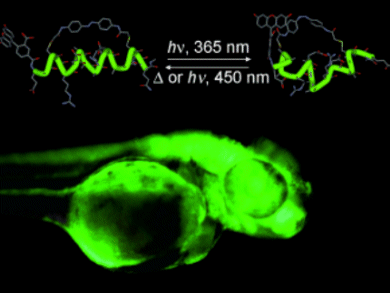The direct external control of biological function in vivo is an important research method. Scientists from the University of Toronto, Canada, have combined in vivo fluorescence and photochromic control of small molecules to analyze the early development of zebrafish embryos.
The in vivo observations of the developing biological system were achieved by using photoswitchable peptides based on azobenzene units. In these compounds, the peptide structure is changed by the photoinduced cis/trans isomerisation of the azobenzene groups (see figure). Because azobenzene was used as a light-sensitive fluorescence switch in live cells, the authors were able to use the fluorescence data to determine the kinetics of the cis/trans conformational change of the protein.
- Fluorescence Imaging of Azobenzene Photoswitching In Vivo
A. A. Beharry, L. Wong, V. Tropepe, G. A. Woolley,
Angew. Chem. Int. Ed. 2011, 50.
DOI: 10.1002/anie.201006506 - A. A. Beharry, L. Wong, V. Tropepe, G. A. Woolley,
Angew. Chem. 2011, 123.
DOI: 10.1002/ange.201006506




